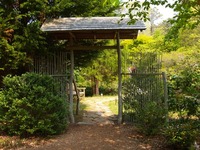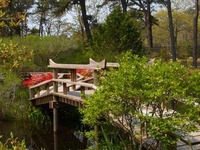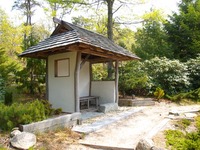Somehow in decades of visiting Martha’s Vineyard, I had never explored the Mytoi garden on Chappaquiddick until this past Memorial Day weekend. It is 
inner gateexquisite. Originally created in the ‘50s by Mary Wakeman with the aid and advice of her architect Hugh Jones, the property is now owned by the The Trustees of Reservations. Apparently it was nearly destroyed by Hurricane Bob in 1991 but has since been revived thanks to a new master plan by landscape designer Julie Moir Messervy. She’s the co-author with Sarah Susanka of the recent Taunton book, Outside the Not So Big House. Today’s refurbished four-acre garden is a delightful hybrid of the Island environment and a Japanese aesthetic.
The integral relationship between landscape and built structure that I find so appealing in Japanese design is evident in abundance at Mytoi. It is  essentially a structured landscape. You enter the public-access garden through a modest gateway that is the first transition from the outer world to the peaceful sanctuary within. After traveling an initial, largely shaded path among whispering birch trees, you arrive at a somewhat more elaborate inner gateway with a glimpse of a winding stone path ahead, beyond the shade. From there the garden gradually unfolds revealing its centerpiece: a stream-fed, shallow pond with small center island, bursting with pink and salmon-colored azaleas, which is traversed by a meandering, climbing and descending footbridge.
essentially a structured landscape. You enter the public-access garden through a modest gateway that is the first transition from the outer world to the peaceful sanctuary within. After traveling an initial, largely shaded path among whispering birch trees, you arrive at a somewhat more elaborate inner gateway with a glimpse of a winding stone path ahead, beyond the shade. From there the garden gradually unfolds revealing its centerpiece: a stream-fed, shallow pond with small center island, bursting with pink and salmon-colored azaleas, which is traversed by a meandering, climbing and descending footbridge.
This isn’t a Japanese Zen garden of formally raked sand around sculptural stones, but a Japanese-style strolling pond garden. Landscape markers keyed to a garden map identify the most-asked-about trees, flowering shrubs, and the occasional plant. There’s plenty of lush greenery softening edges and drawing the eye upward and around. One of my favorites was a Japanese Threadleaf Maple which is a delicate, low, fringe-like tree. There are several Stewartia in the mix (that I’m learning to recognize by their gorgeous, leathery bark), a Dwarf White Pine that caught my eye, and an impressive Threadleaf Falsecypress among many more thriving native and exotic specimens.
Of course my attention was drawn in short order to a small hut-like structure on the higher ground overlooking the pond. According to one of the gardeners hard at work near the hut, its design by Don Sibley (Mytoi gardener and landscape painter) was based on the Japanese sheltered waiting area that traditionally accommodates those gathering for a tea ceremony.
It’s a small three-sided structure, maybe eight feet by five feet that includes a bench and standing area. It has an overhanging cedar shingle, center-gable  roof that wraps into a hip roof at opposite ends, all with exposed framing. Free-form tree limbs stripped of their bark frame the walls and an open-air window on one end. Another smaller, eye-level, open rectangular window on the opposite end and higher triangular gable windows are framed with planed wood. Each window in-turn frames a specific view of the landscape. The walls are infilled with what appears to be white stucco. Sibley paid careful attention to the materiality and composition of the floor. Large rectangular granite stones
roof that wraps into a hip roof at opposite ends, all with exposed framing. Free-form tree limbs stripped of their bark frame the walls and an open-air window on one end. Another smaller, eye-level, open rectangular window on the opposite end and higher triangular gable windows are framed with planed wood. Each window in-turn frames a specific view of the landscape. The walls are infilled with what appears to be white stucco. Sibley paid careful attention to the materiality and composition of the floor. Large rectangular granite stones  form a threshold just outside the building perimeter that transitions to a white pea stone and then flush-laid granite pavers within. A solitary, rough hewn piece of granite punctuates the flooring, standing about ten inches above grade to form a foot rest or low bench. The dirt path that runs in front of the hut is bordered by railroad ties that are periodically interrupted by field stones, forming a fine-detail example of the garden’s constant dialogue between landscape and built structure.
form a threshold just outside the building perimeter that transitions to a white pea stone and then flush-laid granite pavers within. A solitary, rough hewn piece of granite punctuates the flooring, standing about ten inches above grade to form a foot rest or low bench. The dirt path that runs in front of the hut is bordered by railroad ties that are periodically interrupted by field stones, forming a fine-detail example of the garden’s constant dialogue between landscape and built structure.
I joked with my husband that this little building’s function was reminiscent of one of my early RISD architecture school assignments to design “an enclosure in a field”. At the time, almost twenty years ago, we had made much fun of what sounded like a typically esoteric, vague assignment. As I recall, the crit for my “enclosure in a field” had ended with me in tears in the ladies’ room while my critic tried to console me from the other side of the stall. Ah, memories. If only I had designed something as nuanced and inviting as the Mytoi hut.
After pausing in the hut and taking in the view, you can continue farther up the hillside through a juniper planting and then down toward a small bamboo thicket near a picnic area and over the stream again. This brings you nearly full circle back to the birch walk. On our visit I could have repeated the circle again, happily, but I had to head off to the next event. I’m glad, though, that I had a chance to slow down, even if briefly, to enjoy such a peaceful, contemplative garden. It’s a real treat. Put it on your list as a must-see.
thicket near a picnic area and over the stream again. This brings you nearly full circle back to the birch walk. On our visit I could have repeated the circle again, happily, but I had to head off to the next event. I’m glad, though, that I had a chance to slow down, even if briefly, to enjoy such a peaceful, contemplative garden. It’s a real treat. Put it on your list as a must-see.
by Katie Hutchison for the House Enthusiast
To visit go to The Trustees of Reservations website.

